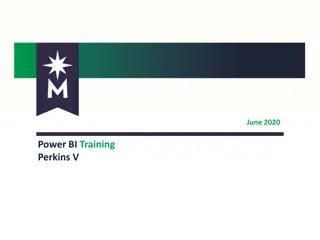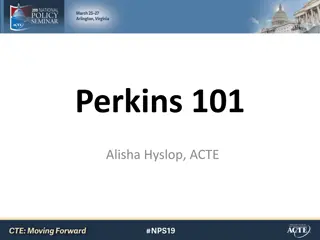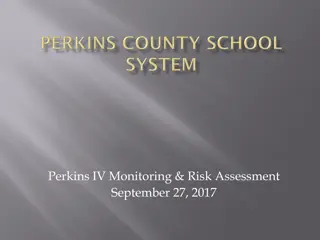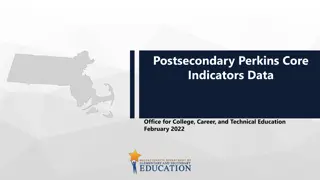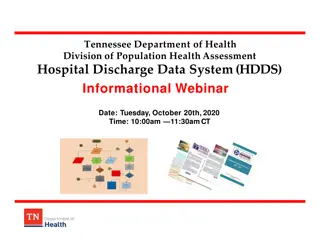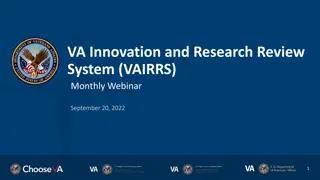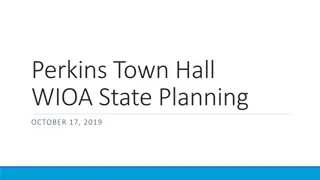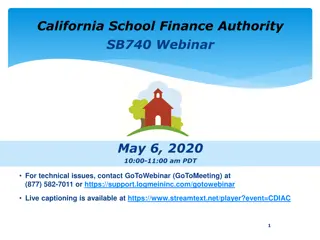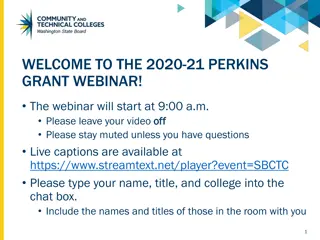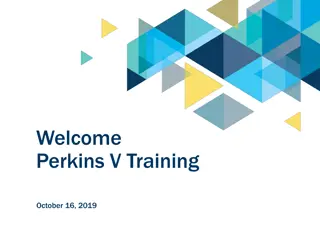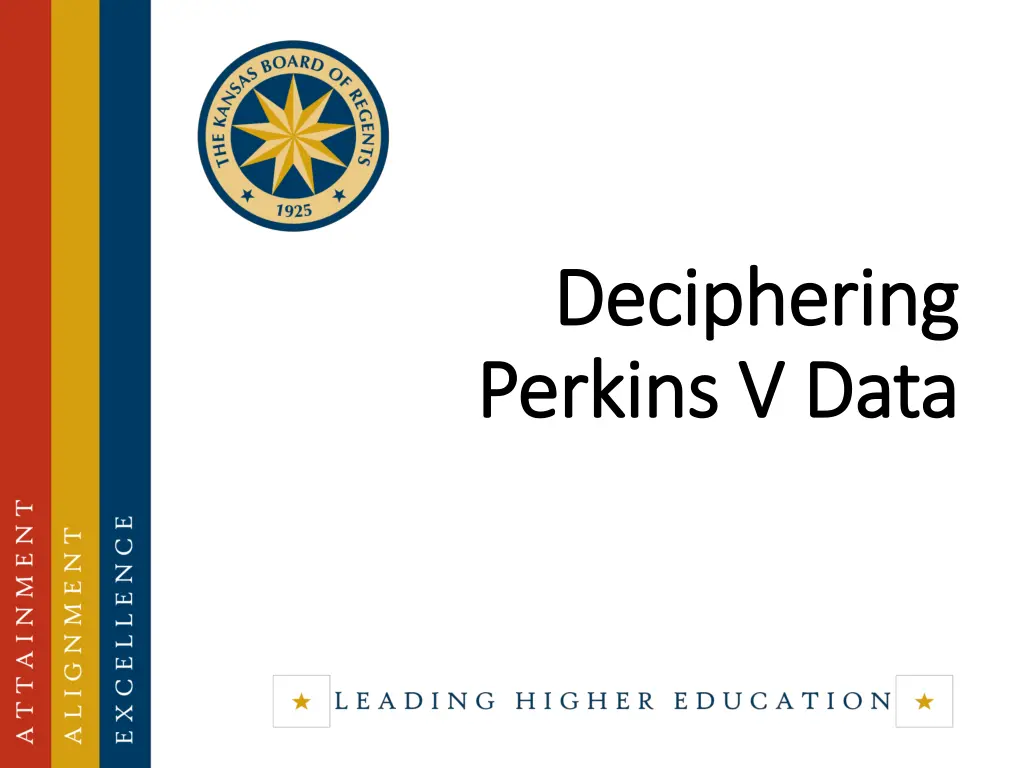
Understanding Perkins V Data and Core Indicators for Program Accountability
Explore the importance of Perkins V data and core indicators for assessing program performance and accountability. Learn about certification deadlines, reporting requirements, and the role of KHEDS data in distributing Perkins funds. Gain insights into postsecondary core indicators and the key elements affecting program outcomes.
Download Presentation

Please find below an Image/Link to download the presentation.
The content on the website is provided AS IS for your information and personal use only. It may not be sold, licensed, or shared on other websites without obtaining consent from the author. If you encounter any issues during the download, it is possible that the publisher has removed the file from their server.
You are allowed to download the files provided on this website for personal or commercial use, subject to the condition that they are used lawfully. All files are the property of their respective owners.
The content on the website is provided AS IS for your information and personal use only. It may not be sold, licensed, or shared on other websites without obtaining consent from the author.
E N D
Presentation Transcript
Deciphering Deciphering Perkins V Data Perkins V Data
2018, 2019, 2020.wait, what year is it?? DL, NF .What does this all mean ??? Perkins V Data Reports
Calendar Reminders Currently in Perkins plan year FY21 Institutions currently reporting AY20 data Certification deadline 9/21/20 Can pull follow-up report and begin work after certification Follow-up reporting opens 1/4/21 Follow-up reporting closes 2/26/21 Will roll over to AY21 (Summer 20, Fall 20, Spring 21) at end of September Changes to course/program inventory: wait until after certification, or make change effective after 7/1/20
Accountability Accountability Core Indicators = indicators of performance Program performance rolls up to institutional performance Institutional performance targets are negotiated with the State Kansas institutional performance rolls up to State performance Kansas negotiates performance targets with The U.S. Department of Education Reaching State performance targets ensures that Kansas receives Perkins funds
Core Indicators Core Indicators Placement 2nd Qtr after exit Still enrolled in postsecondary education Advanced training Military service Peace Corps Employed 1P1: Why is KHEDS data important to Perkins V? KHEDS Data is used to calculate core indicators and is used to distribute Perkins funds. 2P1: recent program through 1 year after exit (this indicator lags a year) Credential, Certificate or Degree during 3P1: non-traditional (gender) fields Concentrators in CTE programs leading to
Perkins V Postsecondary Core Indicators PERKINS V PERFORMANCE - POSTSECONDARY CORE INDICATORS The Statute Language Numerator CTE Concentrators who, during the 2nd quarter after exit, remain enrolled in postsecondary education, are in advanced training, military service, or a service program, or a service program, or are placed or retained in employment. Denominator The percentage of CTE concentrators who, during the second quarter after program completion, remain enrolled in postsecondary education, are in advanced training, military service, or a service program that receives assistance under title I of the National and Community Service Act of 1990 (42 U.S.C. 12511 et seq.), are volunteers as described in section 5(a) of the Peace Corps Act (22 U.S.C. 2504(a)), or are placed or retained in employment. Completed program of study (reached an exit point). 1P1 Postsecondary Placement Concentrators who received a postsecondary credential during recent program year or within 1 year of completing an exit point The percentage of CTE concentrators who receive a recognized postsecondary credential during participation in or within 1 year of program completion. Number of concentrators who left postsecondary education in the prior reporting year. 2P1 Earned Recognized Postsecondary Credential Concentrators from underrepresented gender groups in CTE programs that lead to non-traditional fields. Number of CTE concentrators in a CTE program or program of study that leads to a nontraditional field The percentage of CTE concentrators in career and technical education programs and programs of study that lead to non- traditional fields. 3P1 Non-trad Program Concentration
Want to know who those students are in the core indicator report? Change drop down to get numerator/denominator numbers Can t remember those darn definitions? Printable PDF right here Returns these results:
Example: Statewide Perkins reporting December 2020. *sample only, not all columns shown
Wait, is it legal to ask these questions? Yes! When can we ask? When the person is a student at your institution How should we gather this information? What are the consequences of not collecting this information?
Perkins V Disclosures The Kansas Higher Education Coordination Act, specifically, K.S.A. 74- 3205d authorizes the Board to collect and analyze data (K.S.A. 74- 3205d(b)(3)) and Compile and coordinate core indicators of quality performance for postsecondary educational institutions. (K.S.A. 74- 3205d (b)(5)). Perkins V focuses on increasing the employment opportunities for populations who are chronically unemployed or underemployed, including individuals with disabilities. The legislation requires eligible recipients to report annually on core indicators of performance, and the data must be disaggregated by special populations with whom participants are served. One of those special populations includes individuals with disabilities. The Board of Regents does not collect the type of disability; rather it collects a yes or no flag as to whether the student has an impairment as defined in the Americans with Disabilities Act (42 U.S.C. 12101 et. seq.). Data is maintained in secure databases, and only authenticated users have access to that data. Data is used for the authorized purpose: core indicators of performance of a federal or state supported program.
Performance Negotiation 2019 Summer meeting projection documents Proposed targets to President/Perkins Coordinator Institution reviews and negotiates targets with KBOR Final agreed upon signed by President
SAMPLE POSTSECONDARY INSTITUTION AY2018 Performance AY2019 Performance CORE INDICATOR AY20 Proposed Target Agreed Upon Target State Target Actual Performance 1P1 Placement/Retention Proposed Target Agreed Upon Target State Target Actual Performance 2P1 Credential/Cert Degree Attainment Proposed Target Agreed Upon Target State Target Actual Performance 3P1 Non-Trad Concentration Yes, we accept the State's proposed targets We want to negotiate our performance targets and suggest the above alternative(s)
Postsecondary Perkins Targets and Performance Perkins V Postsecondary Core Indicator Performance Targets Performance Baseline FY 2020 75 FY 2021 76 FY 2022 76 FY 2023 76 FY 2018 91.12 FY 2019 92.95 1P1: Post-Program Placement 2P1: Earned Recognized Postsecondary Credential 3P1: Non-traditional Program Concentration 75 70 70 70 71 71 80.39 80.39 7 7 7.5 8 8 9.83 11.3 2P1 Cred, Cert or Degree (perf. will chg with NF) 1P1 Placement 3P1 Non-trad concentration 2019 CORE INDICATOR PERFORMANCE - (DL) FY19 State Performance FY20 Target 90% of state target 92.95 75.00 67.50 80.39 70.00 63.00 11.3 7 6.30
Questions? Additional training needed? Perkins grant manager fall meeting September 15, 1-3 p.m.



